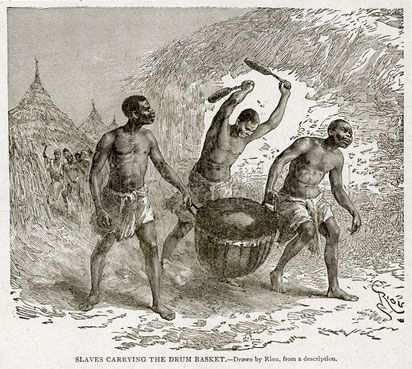
Caption: African slaves carrying a drum basket.
Slaves in the United States relied on music while they worked on the plantations. The art form of "call and response" sustained a rhythm that increased their speed and efficiency. This music trait also allowed slaves to communicate with one another on other plantations (da Gama, 2015).
Motown was no longer prioritizing the mainstream audience and, consequently, assimilating to white culture, but now in its later years, it was beginning to appeal to a wider variety of listeners. Motown’s iconic sweet and melodic sound underwent some changes with most of the Jackson 5’s records, including “ABC.” When hearing this specific hit song, new instruments, like the conga, are introduced into Motown’s new sound (Flory, p. 156). Since the conga is a type of African drum, the band is attempting to incorporate African musical rhythm to mainstream music. Changes in instrumentation reflect the changes in the interest of the audience, which is now more diverse in race and age.
The new audience allows Motown’s artists more freedom with their work as the record label is no longer placing as many restrictions on them. The song also emulates vocals and handclapping familiar to the black community. The performance includes handclapping and footwork along with call and response singing paying homage to the Doo-wop genre and girl group songs from old Motown, which could mirror spiritual music rooted in black culture.
When taking all of these musical components into account, it can be determined that a social statement is being made. By adding to the texture of the song through the inclusion of the conga, call and response, and clapping, the Jackson 5 have created a popular song with African elements that changed the social norm. A new narrative was being written, one that promoted inclusion and diversity.
Caption: A clip from “This Far By Faith,” a PBS series on African American religion.
In the PBS production of “This Far By Faith,” the importance of the Christian religion in the lives of those enslaved was examined. The practice of secret meetings was paired with “ringshout” performances; which were rhythmic expressions of gratitude and hope throughout a lifetime of trouble, fear, and punishment (PBS, 2003).
As with “ringshout” performances, the overflowing feeling of happiness and gratitude are expressed through musical song. The song is partnered with the clapping of hands and tapping of feet as the performers, or even listeners, are able to push the rhythm until it becomes relatable and groovy. It is clear that the Jackson 5 are influenced by the “ringshout” in “ABC” due to the rhythm that is kept by the percussion and the guitar. The driving pulse that these instruments provide make it difficult to resist “catching” the rhythm. Throughout the performance, members of the group all clapped and stomped their feet, individually or as a collective. The action of the synchronized hand-clapping and stomping of the feet symbolize togetherness and unity. This meaning held true in the early African-American history and it is still applicable throughout the career of the unified brother group.
